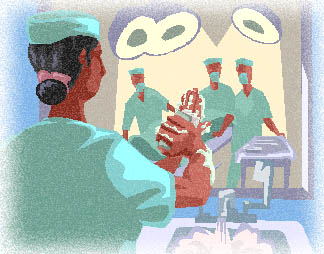Solutions to Treating Obesity
Three basic treatments are used as solutions in treating obesity which include behavioral therapy and counseling, weight loss drugs, and sometimes in severe cases, weight loss surgery. However, not only are treatment methods chosen to match the level of obesity, but of health conditions and motivation in losing weight. A series of major changes need to occur in a life-long effort to control obesity, including changes in eating habits, exercise, and lifestyle.

Image Source: http://www.le.ac.uk/li/sources/subject8/surgery.jpg
Behavioral and family counseling are just one element in treating obesity with behavioral therapy. In this type of counseling, behavior adjustments and behavioral skills are modified in order to change eating habits and physical activity. Dietary counseling, another type, is divided into two main types; a low calorie diet or the very low calorie diet. Complex carbohydrates replace the high calorie and low volume foods, along with increasing fruits and vegetable and reducing the amount of fat intake. The last type of counseling method is geared towards exercising. For example sedentary people are needed to be moved into an active category as moderate individuals are moved to more vigorous levels. In doing so, promoting less overweight and obese lifestyles such as snacking while watching excessive television, are used in treatment. Continued physical activity (exercise, sports, etc…) is vital even after treatment to keep weight off and reduce the threat of post weight loss effects.
Medications, prescription or not, are modestly effective in treating obesity. If unable to lose weight through diet and exercise or because of health conditions, doctors will sometimes recommend prescription weight loss drugs such as Dexfenfluramine (Redux), Diethylopropion (Tenuate), Mazindol (Sanorex), Orlistat (Xenical), and Sibutramine (Meridia). However, these drugs are suggested rather for the obese then for the mildly overweight. Non-prescription weight loss drugs are available and function as an “appetite-suppressant,” a prime example being anti-depression medicine. These “appetite suppressants solve weight loss by decreasing appetite or increasing the “full” sensation. To do so, however, the two main brain chemicals that affect mood and appetite, serotonin and catecholamine, need to be increased. One must remember that weight loss medications respond differently to a variety of people and that some might experience more weight loss than others. Also, medicines are used to help a person stay on a diet and exercise plan.

Image Source: http://www.eparent.com/resources/asktheexperts/images/medication.jpg
When dealing with medications, many potential risks are inevitable. The possibility of abuse and developing a tolerance is major, therefore, patients need to follow the guided directions. Medicines affecting catecholamine levels can cause symptoms of sleeplessness, nervousness, and euphoria. Side effects and minor risks include elevated blood pressure, oily spotting, and increased number of bowel movements.
The last type of treatment after both counseling and weight loss drugs have failed is weight loss surgery known as gastrointestinal surgery. This surgery promotes weight loss by restricting food intake and sometimes interrupting the digestive process. Candidates for gastrointestinal surgery need to have a body mass index (BMI) above 40 or people with a BMI between 35-40 who suffer from diabetes or a life-threatening cardiopulmonary condition. In simpler terms about 100 pounds overweight for males and 80 pounds overweight in females.
When pertaining to children, however, different steps are taken to insure treatment, such as family therapy. Family therapy is more effective then diet and exercise in preventing continuous weight gain. Very low calorie diets are not advisable as well as developing a structured aerobic schedule for children. A more active daily lifestyle should be encouraged.
It also must be mentioned that none of the treatments listed above are not guaranteed. Professionals and doctors need to make sure the patient’s weight loss program/ goal is attainable and should remember to congratulate patients on their efforts. Weight loss is a life long effort and requires full cooperation and commitment to be successful.
Solutions to Preventing Obesity
Certain measures and structural changes need to be taken in the effort to prevent obesity. Here is a brief explanation of a few helpful but necessary steps. Possibly the most important step in preventing obesity is insuring the education from parents to children of healthy eating and physical activity. However, before this can happen parents as well as adults need to understand. Plenty of nutritional information is available but how many people can say they fully comprehend what they are reading, or even know what a calorie is, let alone how to burn one. The medical community needs to influence schools in allowing more time and stressing the importance of physical activity. Healthy school lunch programs as well as wellness courses in high school should be reevaluated and encouraged as much as possible. If children learn and practice a healthy lifestyle early in life it can help them to prevent unhealthy eating habits and avoid a sedentary lifestyle.
Obesity is also an economic phenomenon. In the lower-income states such as Mississippi, Alabama, Louisiana, and West Virginia coincidently have the highest obesity rates. Why is this? Cheap snacking and cheap fast food offers are far less expensive then cooking one’s own meal or going out to eat in a restaurant, where you most likely will eat healthier.

Image Source: http://www.liposuction-costs.com/obesity.gif
In an effort to help, restaurants as well as fast food joints should post calorie levels. Nutritional labels on food products should be readily accessible and made easy to understand before purchasing. In a study, sixty to eighty percent of people said they read the label before consuming a new food item but only thirty to forty percent said the label influences their buying.
Lastly arranging necessary means for overweight and obese persons need to be taken in treating obesity and preventing more weight gain. Obese patients should be comfortable while in healthcare offices. Larger fitting scales, blood pressure cuffs and gowns need to be made available. Waiting room chairs without arms would also help in comforting the patient.

